Leadership Research Paper: Styles and Qualities in Sports
VerifiedAdded on 2022/11/17
|10
|3171
|200
Report
AI Summary
This report provides a comprehensive literature review on leadership within the context of sports. It begins by establishing the significance of leadership and its influence on team dynamics and individual performance. The review then delves into various leadership styles, including autocratic, democratic, and laissez-faire approaches, analyzing their respective strengths and weaknesses. It emphasizes the importance of understanding the qualities of a good leader, both in general terms and specifically within the sports domain, highlighting attributes such as honesty, communication, motivation, and decision-making abilities. Furthermore, the report explores the development of a leadership philosophy, emphasizing the need for a clear system of beliefs that guides decision-making and fosters a winning culture. The review draws upon several research papers and provides examples of successful leadership philosophies. In conclusion, the report underscores the critical role of leadership in achieving success in sports, emphasizing the need for continuous development and research in this area.

Leadership
Paraphrase This Document
Need a fresh take? Get an instant paraphrase of this document with our AI Paraphraser
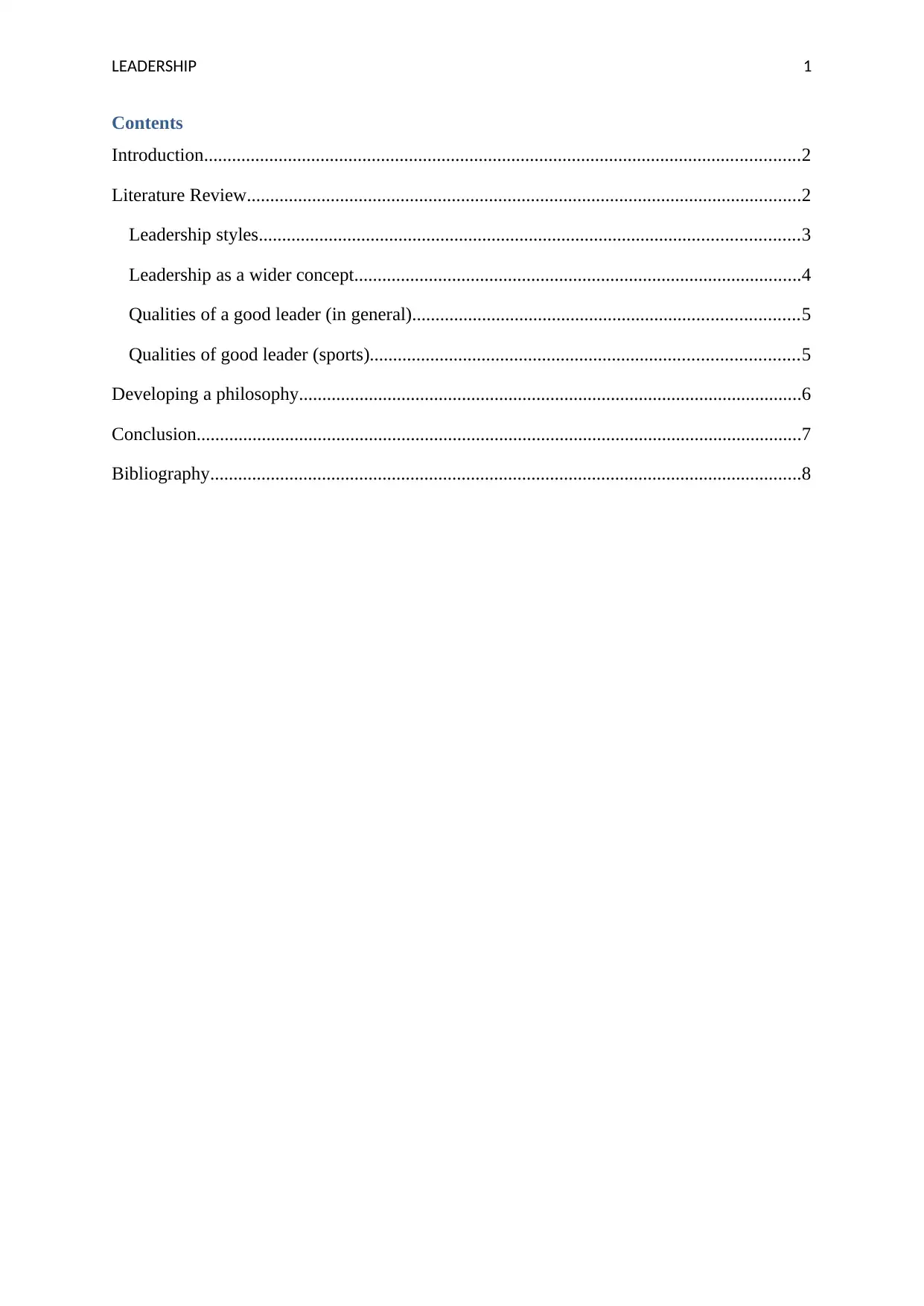
LEADERSHIP 1
Contents
Introduction................................................................................................................................2
Literature Review.......................................................................................................................2
Leadership styles....................................................................................................................3
Leadership as a wider concept................................................................................................4
Qualities of a good leader (in general)...................................................................................5
Qualities of good leader (sports)............................................................................................5
Developing a philosophy............................................................................................................6
Conclusion..................................................................................................................................7
Bibliography...............................................................................................................................8
Contents
Introduction................................................................................................................................2
Literature Review.......................................................................................................................2
Leadership styles....................................................................................................................3
Leadership as a wider concept................................................................................................4
Qualities of a good leader (in general)...................................................................................5
Qualities of good leader (sports)............................................................................................5
Developing a philosophy............................................................................................................6
Conclusion..................................................................................................................................7
Bibliography...............................................................................................................................8
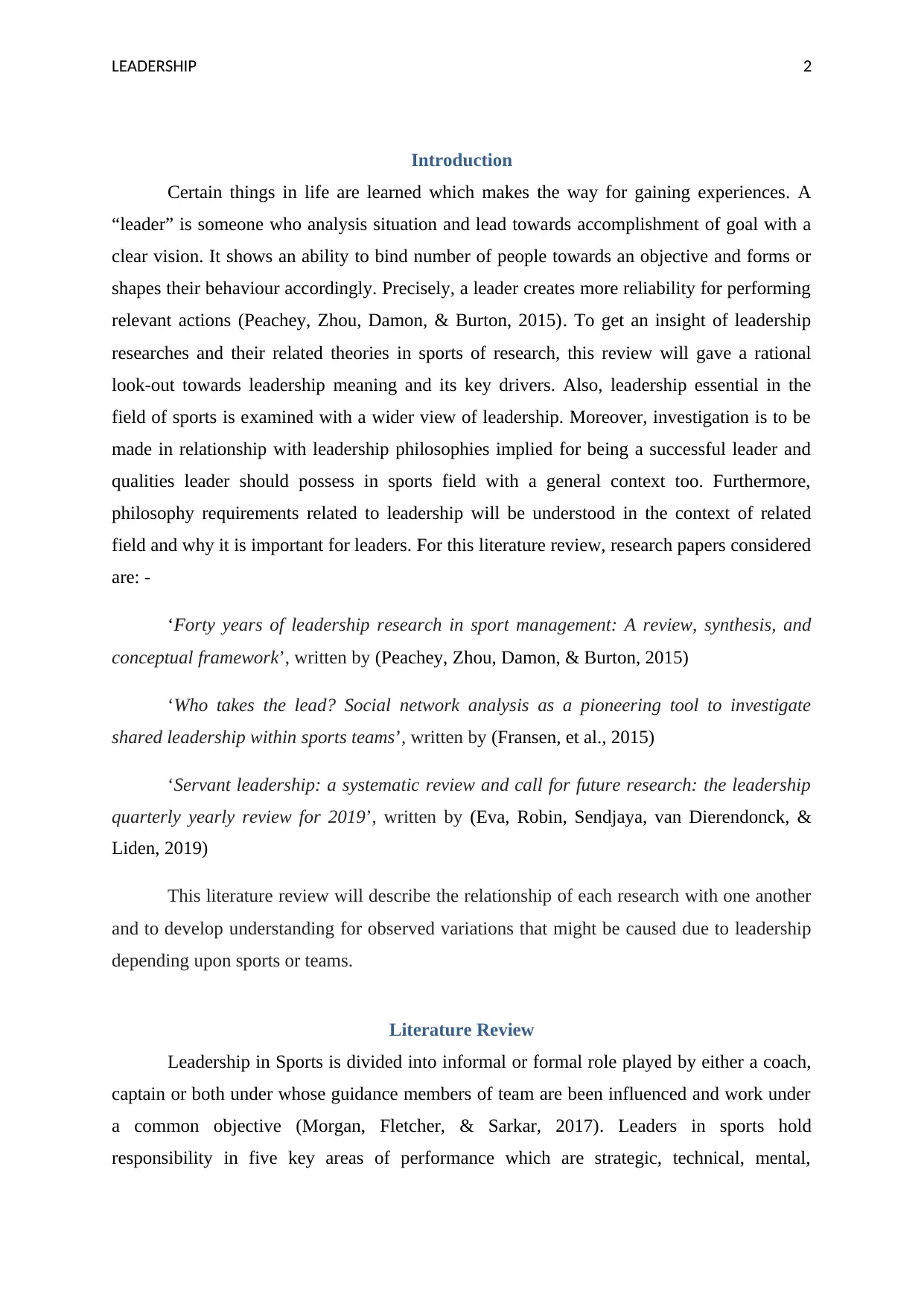
LEADERSHIP 2
Introduction
Certain things in life are learned which makes the way for gaining experiences. A
“leader” is someone who analysis situation and lead towards accomplishment of goal with a
clear vision. It shows an ability to bind number of people towards an objective and forms or
shapes their behaviour accordingly. Precisely, a leader creates more reliability for performing
relevant actions (Peachey, Zhou, Damon, & Burton, 2015). To get an insight of leadership
researches and their related theories in sports of research, this review will gave a rational
look-out towards leadership meaning and its key drivers. Also, leadership essential in the
field of sports is examined with a wider view of leadership. Moreover, investigation is to be
made in relationship with leadership philosophies implied for being a successful leader and
qualities leader should possess in sports field with a general context too. Furthermore,
philosophy requirements related to leadership will be understood in the context of related
field and why it is important for leaders. For this literature review, research papers considered
are: -
‘Forty years of leadership research in sport management: A review, synthesis, and
conceptual framework’, written by (Peachey, Zhou, Damon, & Burton, 2015)
‘Who takes the lead? Social network analysis as a pioneering tool to investigate
shared leadership within sports teams’, written by (Fransen, et al., 2015)
‘Servant leadership: a systematic review and call for future research: the leadership
quarterly yearly review for 2019’, written by (Eva, Robin, Sendjaya, van Dierendonck, &
Liden, 2019)
This literature review will describe the relationship of each research with one another
and to develop understanding for observed variations that might be caused due to leadership
depending upon sports or teams.
Literature Review
Leadership in Sports is divided into informal or formal role played by either a coach,
captain or both under whose guidance members of team are been influenced and work under
a common objective (Morgan, Fletcher, & Sarkar, 2017). Leaders in sports hold
responsibility in five key areas of performance which are strategic, technical, mental,
Introduction
Certain things in life are learned which makes the way for gaining experiences. A
“leader” is someone who analysis situation and lead towards accomplishment of goal with a
clear vision. It shows an ability to bind number of people towards an objective and forms or
shapes their behaviour accordingly. Precisely, a leader creates more reliability for performing
relevant actions (Peachey, Zhou, Damon, & Burton, 2015). To get an insight of leadership
researches and their related theories in sports of research, this review will gave a rational
look-out towards leadership meaning and its key drivers. Also, leadership essential in the
field of sports is examined with a wider view of leadership. Moreover, investigation is to be
made in relationship with leadership philosophies implied for being a successful leader and
qualities leader should possess in sports field with a general context too. Furthermore,
philosophy requirements related to leadership will be understood in the context of related
field and why it is important for leaders. For this literature review, research papers considered
are: -
‘Forty years of leadership research in sport management: A review, synthesis, and
conceptual framework’, written by (Peachey, Zhou, Damon, & Burton, 2015)
‘Who takes the lead? Social network analysis as a pioneering tool to investigate
shared leadership within sports teams’, written by (Fransen, et al., 2015)
‘Servant leadership: a systematic review and call for future research: the leadership
quarterly yearly review for 2019’, written by (Eva, Robin, Sendjaya, van Dierendonck, &
Liden, 2019)
This literature review will describe the relationship of each research with one another
and to develop understanding for observed variations that might be caused due to leadership
depending upon sports or teams.
Literature Review
Leadership in Sports is divided into informal or formal role played by either a coach,
captain or both under whose guidance members of team are been influenced and work under
a common objective (Morgan, Fletcher, & Sarkar, 2017). Leaders in sports hold
responsibility in five key areas of performance which are strategic, technical, mental,
⊘ This is a preview!⊘
Do you want full access?
Subscribe today to unlock all pages.

Trusted by 1+ million students worldwide
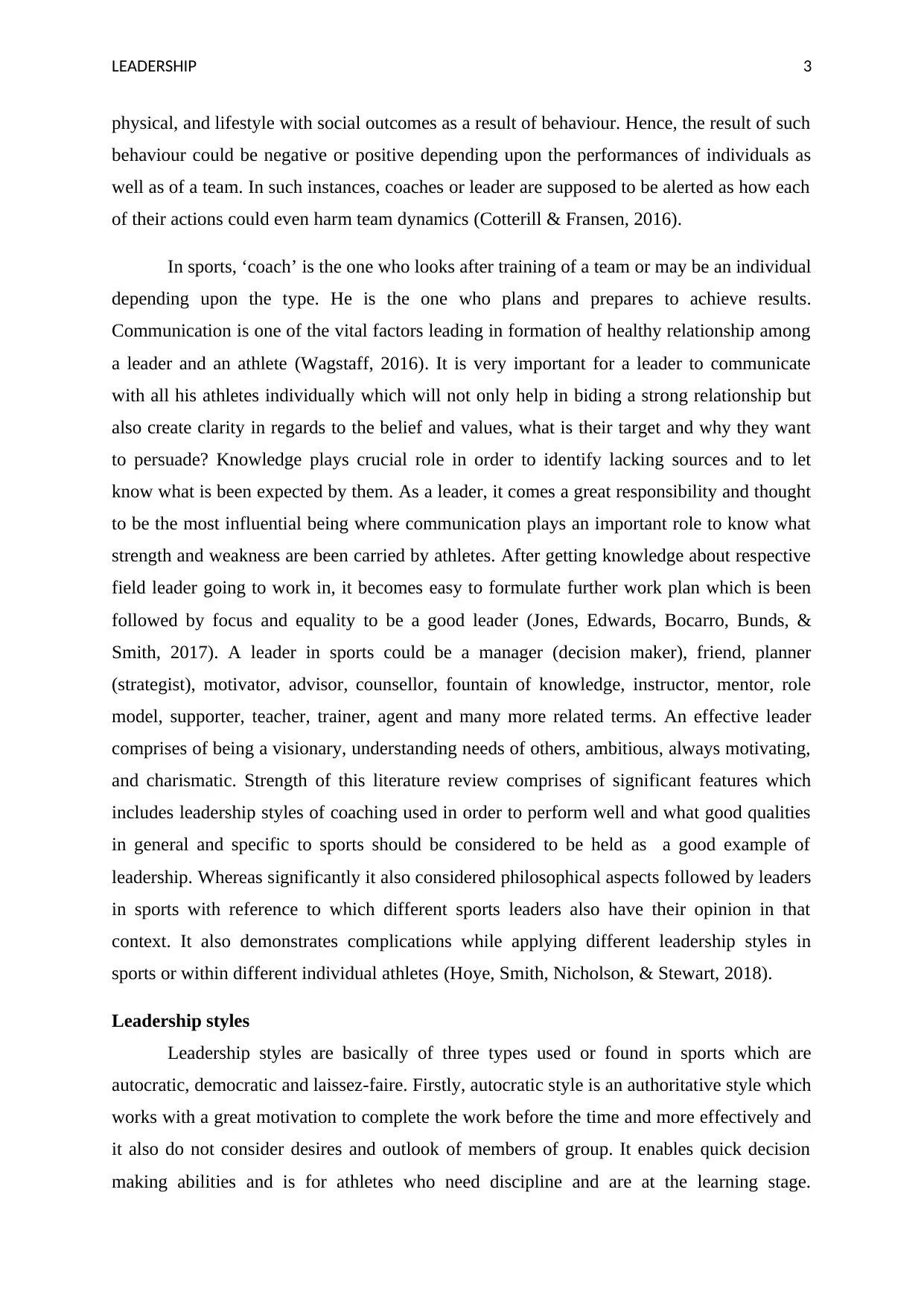
LEADERSHIP 3
physical, and lifestyle with social outcomes as a result of behaviour. Hence, the result of such
behaviour could be negative or positive depending upon the performances of individuals as
well as of a team. In such instances, coaches or leader are supposed to be alerted as how each
of their actions could even harm team dynamics (Cotterill & Fransen, 2016).
In sports, ‘coach’ is the one who looks after training of a team or may be an individual
depending upon the type. He is the one who plans and prepares to achieve results.
Communication is one of the vital factors leading in formation of healthy relationship among
a leader and an athlete (Wagstaff, 2016). It is very important for a leader to communicate
with all his athletes individually which will not only help in biding a strong relationship but
also create clarity in regards to the belief and values, what is their target and why they want
to persuade? Knowledge plays crucial role in order to identify lacking sources and to let
know what is been expected by them. As a leader, it comes a great responsibility and thought
to be the most influential being where communication plays an important role to know what
strength and weakness are been carried by athletes. After getting knowledge about respective
field leader going to work in, it becomes easy to formulate further work plan which is been
followed by focus and equality to be a good leader (Jones, Edwards, Bocarro, Bunds, &
Smith, 2017). A leader in sports could be a manager (decision maker), friend, planner
(strategist), motivator, advisor, counsellor, fountain of knowledge, instructor, mentor, role
model, supporter, teacher, trainer, agent and many more related terms. An effective leader
comprises of being a visionary, understanding needs of others, ambitious, always motivating,
and charismatic. Strength of this literature review comprises of significant features which
includes leadership styles of coaching used in order to perform well and what good qualities
in general and specific to sports should be considered to be held as a good example of
leadership. Whereas significantly it also considered philosophical aspects followed by leaders
in sports with reference to which different sports leaders also have their opinion in that
context. It also demonstrates complications while applying different leadership styles in
sports or within different individual athletes (Hoye, Smith, Nicholson, & Stewart, 2018).
Leadership styles
Leadership styles are basically of three types used or found in sports which are
autocratic, democratic and laissez-faire. Firstly, autocratic style is an authoritative style which
works with a great motivation to complete the work before the time and more effectively and
it also do not consider desires and outlook of members of group. It enables quick decision
making abilities and is for athletes who need discipline and are at the learning stage.
physical, and lifestyle with social outcomes as a result of behaviour. Hence, the result of such
behaviour could be negative or positive depending upon the performances of individuals as
well as of a team. In such instances, coaches or leader are supposed to be alerted as how each
of their actions could even harm team dynamics (Cotterill & Fransen, 2016).
In sports, ‘coach’ is the one who looks after training of a team or may be an individual
depending upon the type. He is the one who plans and prepares to achieve results.
Communication is one of the vital factors leading in formation of healthy relationship among
a leader and an athlete (Wagstaff, 2016). It is very important for a leader to communicate
with all his athletes individually which will not only help in biding a strong relationship but
also create clarity in regards to the belief and values, what is their target and why they want
to persuade? Knowledge plays crucial role in order to identify lacking sources and to let
know what is been expected by them. As a leader, it comes a great responsibility and thought
to be the most influential being where communication plays an important role to know what
strength and weakness are been carried by athletes. After getting knowledge about respective
field leader going to work in, it becomes easy to formulate further work plan which is been
followed by focus and equality to be a good leader (Jones, Edwards, Bocarro, Bunds, &
Smith, 2017). A leader in sports could be a manager (decision maker), friend, planner
(strategist), motivator, advisor, counsellor, fountain of knowledge, instructor, mentor, role
model, supporter, teacher, trainer, agent and many more related terms. An effective leader
comprises of being a visionary, understanding needs of others, ambitious, always motivating,
and charismatic. Strength of this literature review comprises of significant features which
includes leadership styles of coaching used in order to perform well and what good qualities
in general and specific to sports should be considered to be held as a good example of
leadership. Whereas significantly it also considered philosophical aspects followed by leaders
in sports with reference to which different sports leaders also have their opinion in that
context. It also demonstrates complications while applying different leadership styles in
sports or within different individual athletes (Hoye, Smith, Nicholson, & Stewart, 2018).
Leadership styles
Leadership styles are basically of three types used or found in sports which are
autocratic, democratic and laissez-faire. Firstly, autocratic style is an authoritative style which
works with a great motivation to complete the work before the time and more effectively and
it also do not consider desires and outlook of members of group. It enables quick decision
making abilities and is for athletes who need discipline and are at the learning stage.
Paraphrase This Document
Need a fresh take? Get an instant paraphrase of this document with our AI Paraphraser
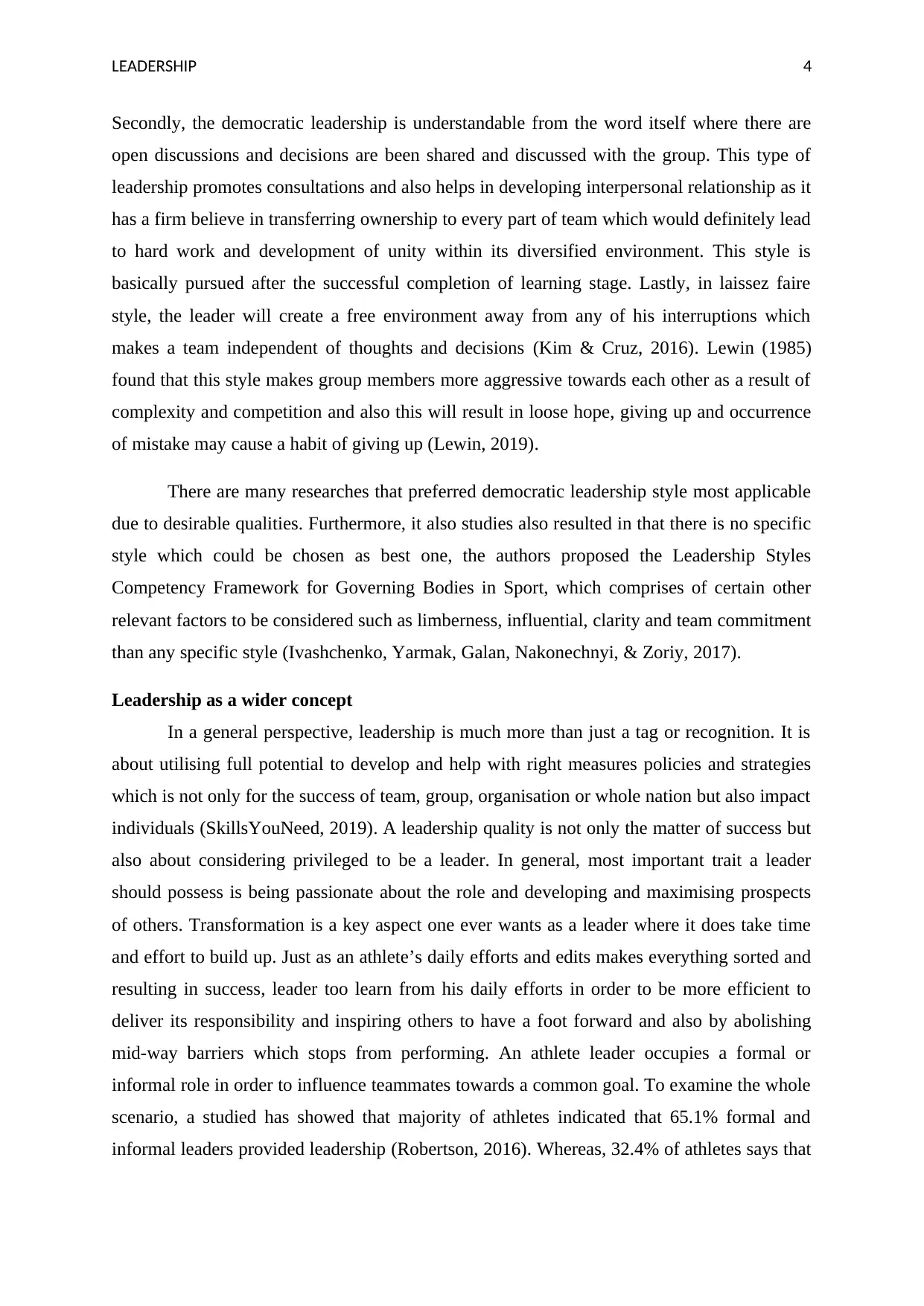
LEADERSHIP 4
Secondly, the democratic leadership is understandable from the word itself where there are
open discussions and decisions are been shared and discussed with the group. This type of
leadership promotes consultations and also helps in developing interpersonal relationship as it
has a firm believe in transferring ownership to every part of team which would definitely lead
to hard work and development of unity within its diversified environment. This style is
basically pursued after the successful completion of learning stage. Lastly, in laissez faire
style, the leader will create a free environment away from any of his interruptions which
makes a team independent of thoughts and decisions (Kim & Cruz, 2016). Lewin (1985)
found that this style makes group members more aggressive towards each other as a result of
complexity and competition and also this will result in loose hope, giving up and occurrence
of mistake may cause a habit of giving up (Lewin, 2019).
There are many researches that preferred democratic leadership style most applicable
due to desirable qualities. Furthermore, it also studies also resulted in that there is no specific
style which could be chosen as best one, the authors proposed the Leadership Styles
Competency Framework for Governing Bodies in Sport, which comprises of certain other
relevant factors to be considered such as limberness, influential, clarity and team commitment
than any specific style (Ivashchenko, Yarmak, Galan, Nakonechnyi, & Zoriy, 2017).
Leadership as a wider concept
In a general perspective, leadership is much more than just a tag or recognition. It is
about utilising full potential to develop and help with right measures policies and strategies
which is not only for the success of team, group, organisation or whole nation but also impact
individuals (SkillsYouNeed, 2019). A leadership quality is not only the matter of success but
also about considering privileged to be a leader. In general, most important trait a leader
should possess is being passionate about the role and developing and maximising prospects
of others. Transformation is a key aspect one ever wants as a leader where it does take time
and effort to build up. Just as an athlete’s daily efforts and edits makes everything sorted and
resulting in success, leader too learn from his daily efforts in order to be more efficient to
deliver its responsibility and inspiring others to have a foot forward and also by abolishing
mid-way barriers which stops from performing. An athlete leader occupies a formal or
informal role in order to influence teammates towards a common goal. To examine the whole
scenario, a studied has showed that majority of athletes indicated that 65.1% formal and
informal leaders provided leadership (Robertson, 2016). Whereas, 32.4% of athletes says that
Secondly, the democratic leadership is understandable from the word itself where there are
open discussions and decisions are been shared and discussed with the group. This type of
leadership promotes consultations and also helps in developing interpersonal relationship as it
has a firm believe in transferring ownership to every part of team which would definitely lead
to hard work and development of unity within its diversified environment. This style is
basically pursued after the successful completion of learning stage. Lastly, in laissez faire
style, the leader will create a free environment away from any of his interruptions which
makes a team independent of thoughts and decisions (Kim & Cruz, 2016). Lewin (1985)
found that this style makes group members more aggressive towards each other as a result of
complexity and competition and also this will result in loose hope, giving up and occurrence
of mistake may cause a habit of giving up (Lewin, 2019).
There are many researches that preferred democratic leadership style most applicable
due to desirable qualities. Furthermore, it also studies also resulted in that there is no specific
style which could be chosen as best one, the authors proposed the Leadership Styles
Competency Framework for Governing Bodies in Sport, which comprises of certain other
relevant factors to be considered such as limberness, influential, clarity and team commitment
than any specific style (Ivashchenko, Yarmak, Galan, Nakonechnyi, & Zoriy, 2017).
Leadership as a wider concept
In a general perspective, leadership is much more than just a tag or recognition. It is
about utilising full potential to develop and help with right measures policies and strategies
which is not only for the success of team, group, organisation or whole nation but also impact
individuals (SkillsYouNeed, 2019). A leadership quality is not only the matter of success but
also about considering privileged to be a leader. In general, most important trait a leader
should possess is being passionate about the role and developing and maximising prospects
of others. Transformation is a key aspect one ever wants as a leader where it does take time
and effort to build up. Just as an athlete’s daily efforts and edits makes everything sorted and
resulting in success, leader too learn from his daily efforts in order to be more efficient to
deliver its responsibility and inspiring others to have a foot forward and also by abolishing
mid-way barriers which stops from performing. An athlete leader occupies a formal or
informal role in order to influence teammates towards a common goal. To examine the whole
scenario, a studied has showed that majority of athletes indicated that 65.1% formal and
informal leaders provided leadership (Robertson, 2016). Whereas, 32.4% of athletes says that
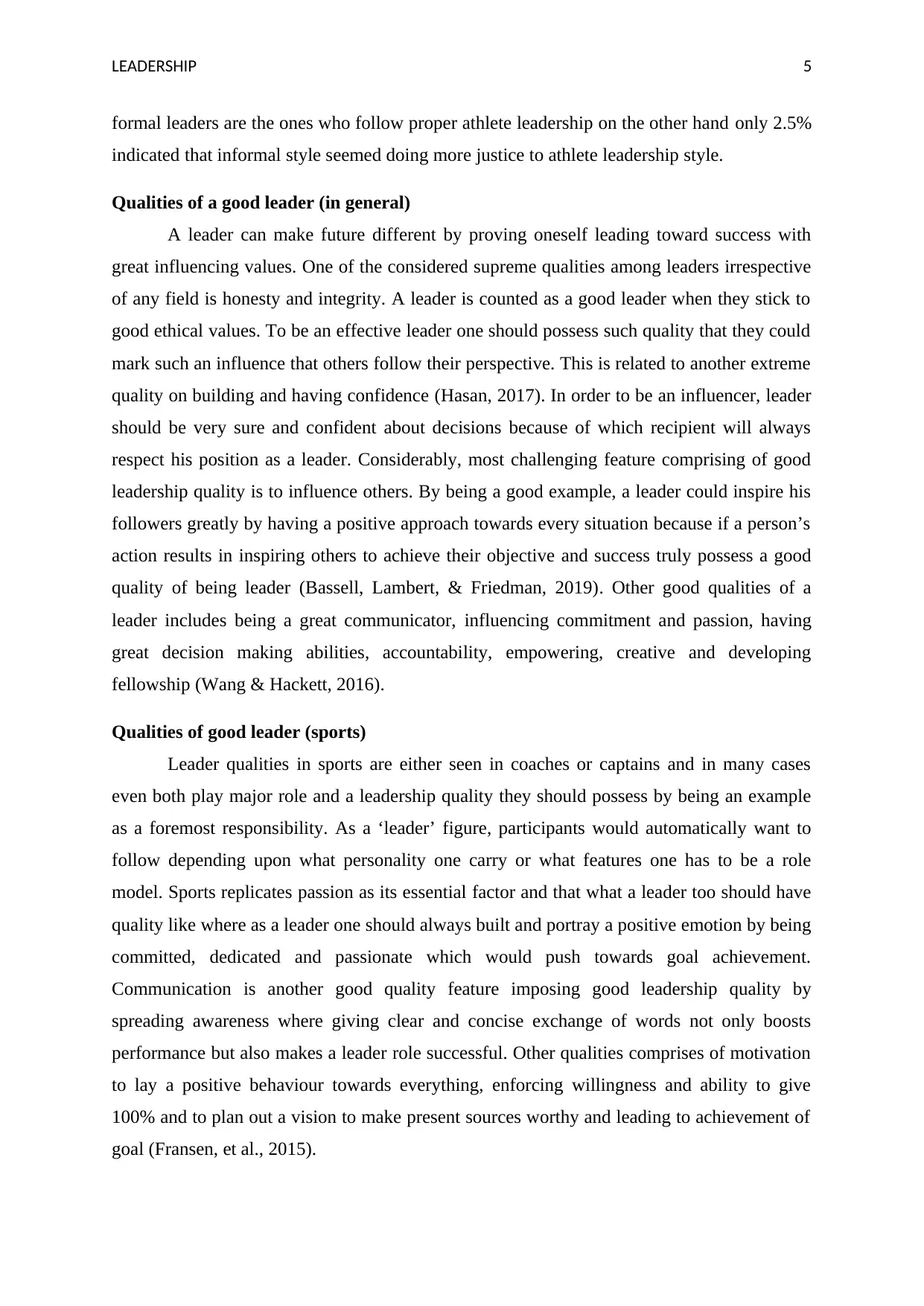
LEADERSHIP 5
formal leaders are the ones who follow proper athlete leadership on the other hand only 2.5%
indicated that informal style seemed doing more justice to athlete leadership style.
Qualities of a good leader (in general)
A leader can make future different by proving oneself leading toward success with
great influencing values. One of the considered supreme qualities among leaders irrespective
of any field is honesty and integrity. A leader is counted as a good leader when they stick to
good ethical values. To be an effective leader one should possess such quality that they could
mark such an influence that others follow their perspective. This is related to another extreme
quality on building and having confidence (Hasan, 2017). In order to be an influencer, leader
should be very sure and confident about decisions because of which recipient will always
respect his position as a leader. Considerably, most challenging feature comprising of good
leadership quality is to influence others. By being a good example, a leader could inspire his
followers greatly by having a positive approach towards every situation because if a person’s
action results in inspiring others to achieve their objective and success truly possess a good
quality of being leader (Bassell, Lambert, & Friedman, 2019). Other good qualities of a
leader includes being a great communicator, influencing commitment and passion, having
great decision making abilities, accountability, empowering, creative and developing
fellowship (Wang & Hackett, 2016).
Qualities of good leader (sports)
Leader qualities in sports are either seen in coaches or captains and in many cases
even both play major role and a leadership quality they should possess by being an example
as a foremost responsibility. As a ‘leader’ figure, participants would automatically want to
follow depending upon what personality one carry or what features one has to be a role
model. Sports replicates passion as its essential factor and that what a leader too should have
quality like where as a leader one should always built and portray a positive emotion by being
committed, dedicated and passionate which would push towards goal achievement.
Communication is another good quality feature imposing good leadership quality by
spreading awareness where giving clear and concise exchange of words not only boosts
performance but also makes a leader role successful. Other qualities comprises of motivation
to lay a positive behaviour towards everything, enforcing willingness and ability to give
100% and to plan out a vision to make present sources worthy and leading to achievement of
goal (Fransen, et al., 2015).
formal leaders are the ones who follow proper athlete leadership on the other hand only 2.5%
indicated that informal style seemed doing more justice to athlete leadership style.
Qualities of a good leader (in general)
A leader can make future different by proving oneself leading toward success with
great influencing values. One of the considered supreme qualities among leaders irrespective
of any field is honesty and integrity. A leader is counted as a good leader when they stick to
good ethical values. To be an effective leader one should possess such quality that they could
mark such an influence that others follow their perspective. This is related to another extreme
quality on building and having confidence (Hasan, 2017). In order to be an influencer, leader
should be very sure and confident about decisions because of which recipient will always
respect his position as a leader. Considerably, most challenging feature comprising of good
leadership quality is to influence others. By being a good example, a leader could inspire his
followers greatly by having a positive approach towards every situation because if a person’s
action results in inspiring others to achieve their objective and success truly possess a good
quality of being leader (Bassell, Lambert, & Friedman, 2019). Other good qualities of a
leader includes being a great communicator, influencing commitment and passion, having
great decision making abilities, accountability, empowering, creative and developing
fellowship (Wang & Hackett, 2016).
Qualities of good leader (sports)
Leader qualities in sports are either seen in coaches or captains and in many cases
even both play major role and a leadership quality they should possess by being an example
as a foremost responsibility. As a ‘leader’ figure, participants would automatically want to
follow depending upon what personality one carry or what features one has to be a role
model. Sports replicates passion as its essential factor and that what a leader too should have
quality like where as a leader one should always built and portray a positive emotion by being
committed, dedicated and passionate which would push towards goal achievement.
Communication is another good quality feature imposing good leadership quality by
spreading awareness where giving clear and concise exchange of words not only boosts
performance but also makes a leader role successful. Other qualities comprises of motivation
to lay a positive behaviour towards everything, enforcing willingness and ability to give
100% and to plan out a vision to make present sources worthy and leading to achievement of
goal (Fransen, et al., 2015).
⊘ This is a preview!⊘
Do you want full access?
Subscribe today to unlock all pages.

Trusted by 1+ million students worldwide
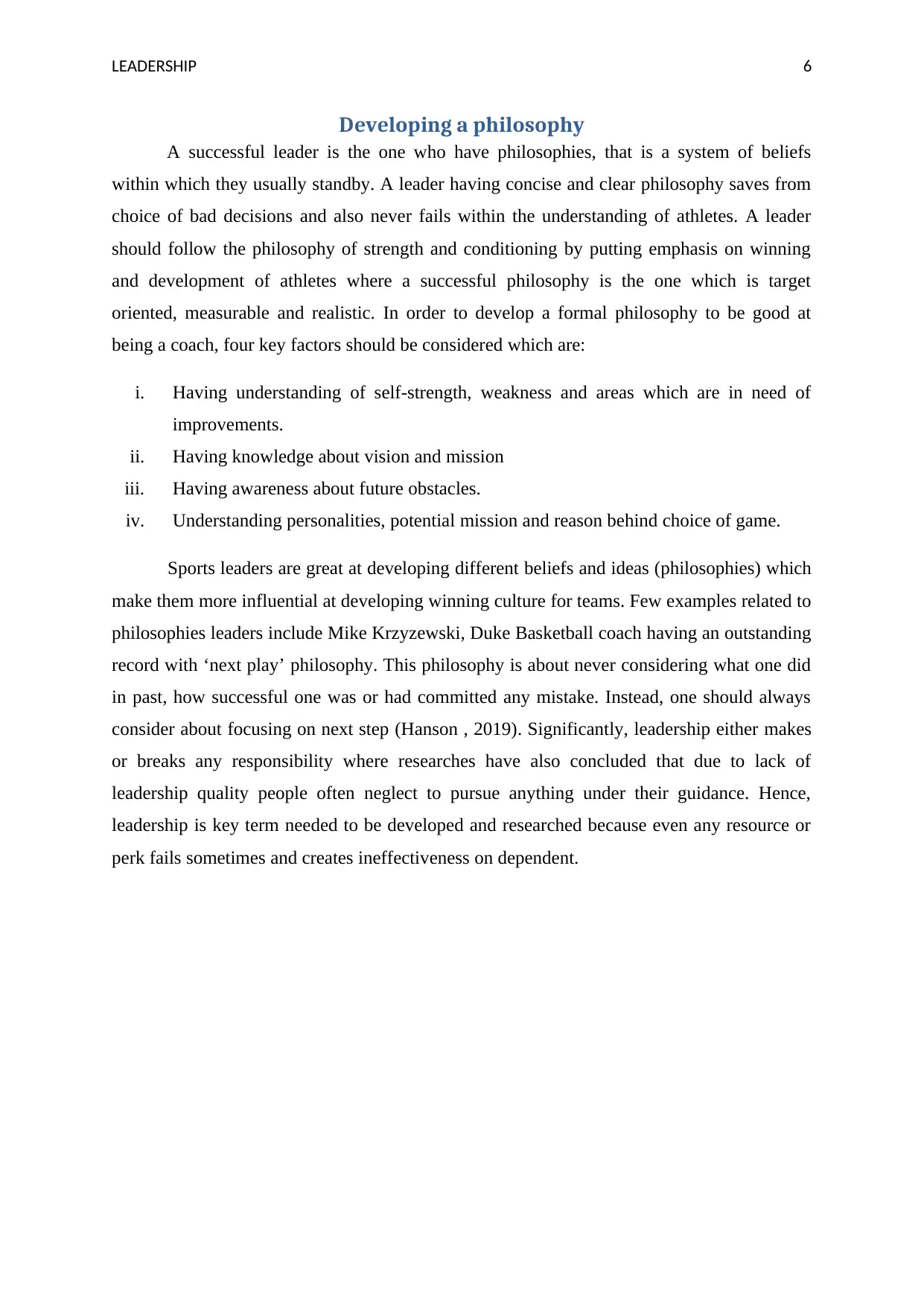
LEADERSHIP 6
Developing a philosophy
A successful leader is the one who have philosophies, that is a system of beliefs
within which they usually standby. A leader having concise and clear philosophy saves from
choice of bad decisions and also never fails within the understanding of athletes. A leader
should follow the philosophy of strength and conditioning by putting emphasis on winning
and development of athletes where a successful philosophy is the one which is target
oriented, measurable and realistic. In order to develop a formal philosophy to be good at
being a coach, four key factors should be considered which are:
i. Having understanding of self-strength, weakness and areas which are in need of
improvements.
ii. Having knowledge about vision and mission
iii. Having awareness about future obstacles.
iv. Understanding personalities, potential mission and reason behind choice of game.
Sports leaders are great at developing different beliefs and ideas (philosophies) which
make them more influential at developing winning culture for teams. Few examples related to
philosophies leaders include Mike Krzyzewski, Duke Basketball coach having an outstanding
record with ‘next play’ philosophy. This philosophy is about never considering what one did
in past, how successful one was or had committed any mistake. Instead, one should always
consider about focusing on next step (Hanson , 2019). Significantly, leadership either makes
or breaks any responsibility where researches have also concluded that due to lack of
leadership quality people often neglect to pursue anything under their guidance. Hence,
leadership is key term needed to be developed and researched because even any resource or
perk fails sometimes and creates ineffectiveness on dependent.
Developing a philosophy
A successful leader is the one who have philosophies, that is a system of beliefs
within which they usually standby. A leader having concise and clear philosophy saves from
choice of bad decisions and also never fails within the understanding of athletes. A leader
should follow the philosophy of strength and conditioning by putting emphasis on winning
and development of athletes where a successful philosophy is the one which is target
oriented, measurable and realistic. In order to develop a formal philosophy to be good at
being a coach, four key factors should be considered which are:
i. Having understanding of self-strength, weakness and areas which are in need of
improvements.
ii. Having knowledge about vision and mission
iii. Having awareness about future obstacles.
iv. Understanding personalities, potential mission and reason behind choice of game.
Sports leaders are great at developing different beliefs and ideas (philosophies) which
make them more influential at developing winning culture for teams. Few examples related to
philosophies leaders include Mike Krzyzewski, Duke Basketball coach having an outstanding
record with ‘next play’ philosophy. This philosophy is about never considering what one did
in past, how successful one was or had committed any mistake. Instead, one should always
consider about focusing on next step (Hanson , 2019). Significantly, leadership either makes
or breaks any responsibility where researches have also concluded that due to lack of
leadership quality people often neglect to pursue anything under their guidance. Hence,
leadership is key term needed to be developed and researched because even any resource or
perk fails sometimes and creates ineffectiveness on dependent.
Paraphrase This Document
Need a fresh take? Get an instant paraphrase of this document with our AI Paraphraser
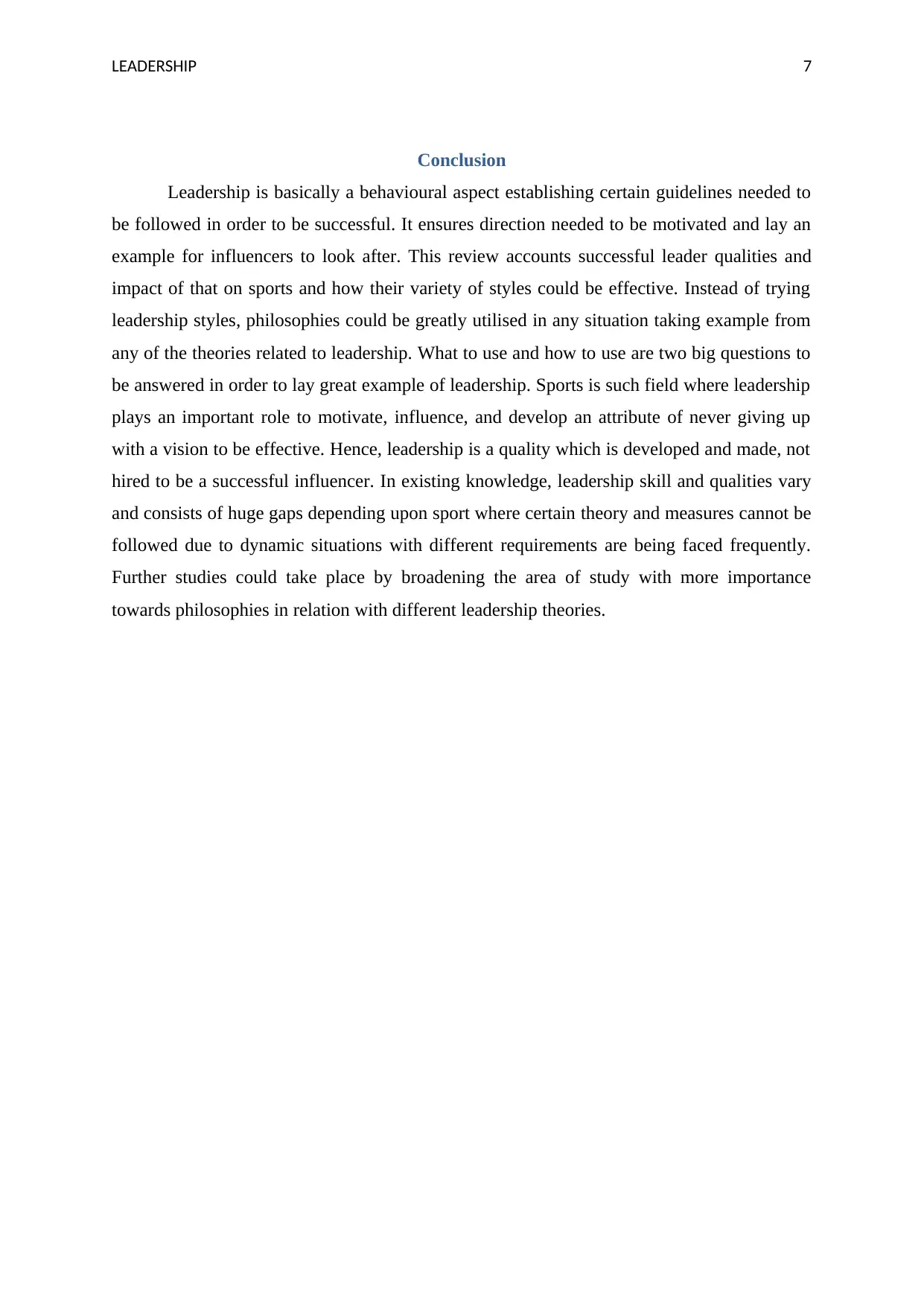
LEADERSHIP 7
Conclusion
Leadership is basically a behavioural aspect establishing certain guidelines needed to
be followed in order to be successful. It ensures direction needed to be motivated and lay an
example for influencers to look after. This review accounts successful leader qualities and
impact of that on sports and how their variety of styles could be effective. Instead of trying
leadership styles, philosophies could be greatly utilised in any situation taking example from
any of the theories related to leadership. What to use and how to use are two big questions to
be answered in order to lay great example of leadership. Sports is such field where leadership
plays an important role to motivate, influence, and develop an attribute of never giving up
with a vision to be effective. Hence, leadership is a quality which is developed and made, not
hired to be a successful influencer. In existing knowledge, leadership skill and qualities vary
and consists of huge gaps depending upon sport where certain theory and measures cannot be
followed due to dynamic situations with different requirements are being faced frequently.
Further studies could take place by broadening the area of study with more importance
towards philosophies in relation with different leadership theories.
Conclusion
Leadership is basically a behavioural aspect establishing certain guidelines needed to
be followed in order to be successful. It ensures direction needed to be motivated and lay an
example for influencers to look after. This review accounts successful leader qualities and
impact of that on sports and how their variety of styles could be effective. Instead of trying
leadership styles, philosophies could be greatly utilised in any situation taking example from
any of the theories related to leadership. What to use and how to use are two big questions to
be answered in order to lay great example of leadership. Sports is such field where leadership
plays an important role to motivate, influence, and develop an attribute of never giving up
with a vision to be effective. Hence, leadership is a quality which is developed and made, not
hired to be a successful influencer. In existing knowledge, leadership skill and qualities vary
and consists of huge gaps depending upon sport where certain theory and measures cannot be
followed due to dynamic situations with different requirements are being faced frequently.
Further studies could take place by broadening the area of study with more importance
towards philosophies in relation with different leadership theories.
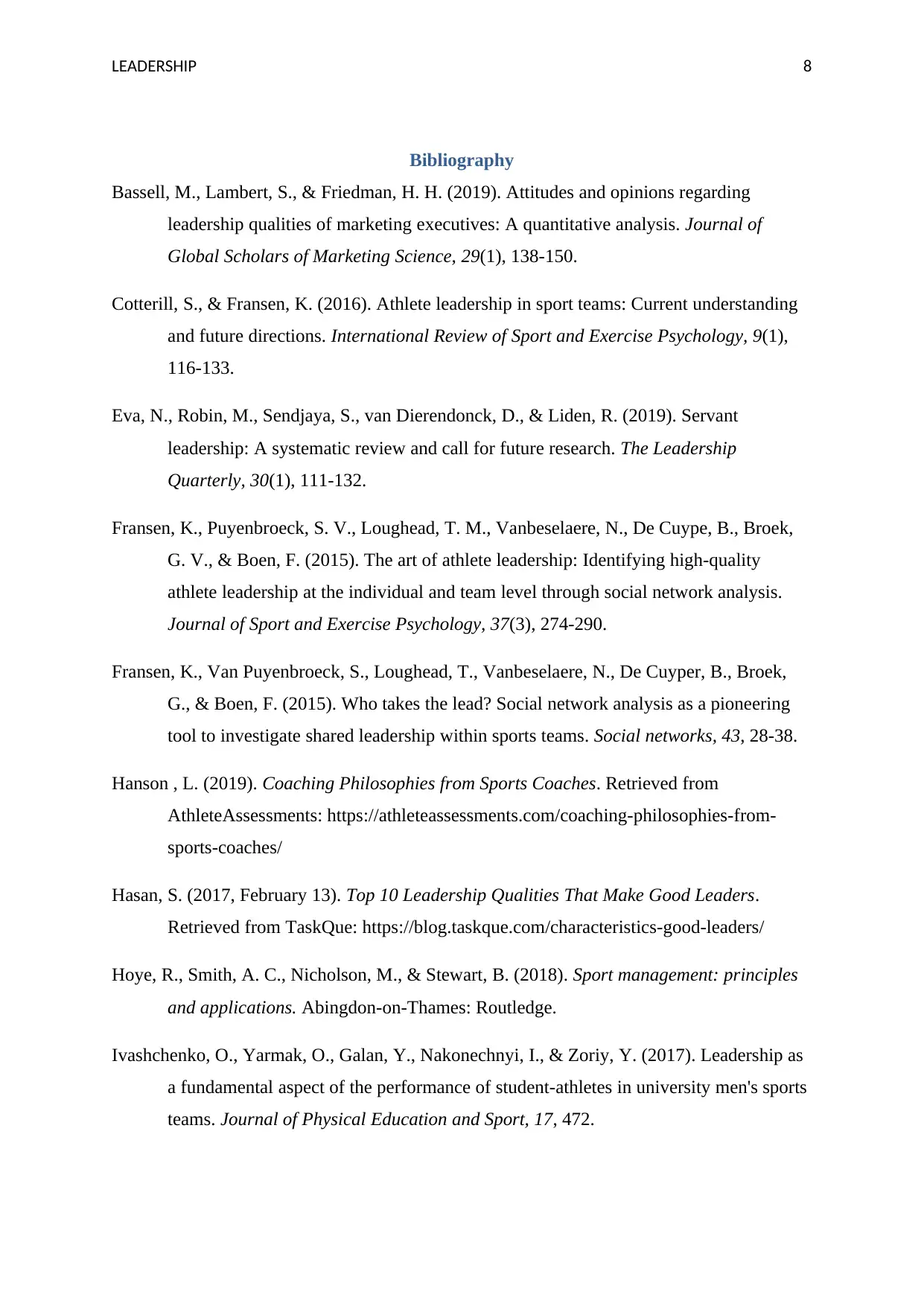
LEADERSHIP 8
Bibliography
Bassell, M., Lambert, S., & Friedman, H. H. (2019). Attitudes and opinions regarding
leadership qualities of marketing executives: A quantitative analysis. Journal of
Global Scholars of Marketing Science, 29(1), 138-150.
Cotterill, S., & Fransen, K. (2016). Athlete leadership in sport teams: Current understanding
and future directions. International Review of Sport and Exercise Psychology, 9(1),
116-133.
Eva, N., Robin, M., Sendjaya, S., van Dierendonck, D., & Liden, R. (2019). Servant
leadership: A systematic review and call for future research. The Leadership
Quarterly, 30(1), 111-132.
Fransen, K., Puyenbroeck, S. V., Loughead, T. M., Vanbeselaere, N., De Cuype, B., Broek,
G. V., & Boen, F. (2015). The art of athlete leadership: Identifying high-quality
athlete leadership at the individual and team level through social network analysis.
Journal of Sport and Exercise Psychology, 37(3), 274-290.
Fransen, K., Van Puyenbroeck, S., Loughead, T., Vanbeselaere, N., De Cuyper, B., Broek,
G., & Boen, F. (2015). Who takes the lead? Social network analysis as a pioneering
tool to investigate shared leadership within sports teams. Social networks, 43, 28-38.
Hanson , L. (2019). Coaching Philosophies from Sports Coaches. Retrieved from
AthleteAssessments: https://athleteassessments.com/coaching-philosophies-from-
sports-coaches/
Hasan, S. (2017, February 13). Top 10 Leadership Qualities That Make Good Leaders.
Retrieved from TaskQue: https://blog.taskque.com/characteristics-good-leaders/
Hoye, R., Smith, A. C., Nicholson, M., & Stewart, B. (2018). Sport management: principles
and applications. Abingdon-on-Thames: Routledge.
Ivashchenko, O., Yarmak, O., Galan, Y., Nakonechnyi, I., & Zoriy, Y. (2017). Leadership as
a fundamental aspect of the performance of student-athletes in university men's sports
teams. Journal of Physical Education and Sport, 17, 472.
Bibliography
Bassell, M., Lambert, S., & Friedman, H. H. (2019). Attitudes and opinions regarding
leadership qualities of marketing executives: A quantitative analysis. Journal of
Global Scholars of Marketing Science, 29(1), 138-150.
Cotterill, S., & Fransen, K. (2016). Athlete leadership in sport teams: Current understanding
and future directions. International Review of Sport and Exercise Psychology, 9(1),
116-133.
Eva, N., Robin, M., Sendjaya, S., van Dierendonck, D., & Liden, R. (2019). Servant
leadership: A systematic review and call for future research. The Leadership
Quarterly, 30(1), 111-132.
Fransen, K., Puyenbroeck, S. V., Loughead, T. M., Vanbeselaere, N., De Cuype, B., Broek,
G. V., & Boen, F. (2015). The art of athlete leadership: Identifying high-quality
athlete leadership at the individual and team level through social network analysis.
Journal of Sport and Exercise Psychology, 37(3), 274-290.
Fransen, K., Van Puyenbroeck, S., Loughead, T., Vanbeselaere, N., De Cuyper, B., Broek,
G., & Boen, F. (2015). Who takes the lead? Social network analysis as a pioneering
tool to investigate shared leadership within sports teams. Social networks, 43, 28-38.
Hanson , L. (2019). Coaching Philosophies from Sports Coaches. Retrieved from
AthleteAssessments: https://athleteassessments.com/coaching-philosophies-from-
sports-coaches/
Hasan, S. (2017, February 13). Top 10 Leadership Qualities That Make Good Leaders.
Retrieved from TaskQue: https://blog.taskque.com/characteristics-good-leaders/
Hoye, R., Smith, A. C., Nicholson, M., & Stewart, B. (2018). Sport management: principles
and applications. Abingdon-on-Thames: Routledge.
Ivashchenko, O., Yarmak, O., Galan, Y., Nakonechnyi, I., & Zoriy, Y. (2017). Leadership as
a fundamental aspect of the performance of student-athletes in university men's sports
teams. Journal of Physical Education and Sport, 17, 472.
⊘ This is a preview!⊘
Do you want full access?
Subscribe today to unlock all pages.

Trusted by 1+ million students worldwide
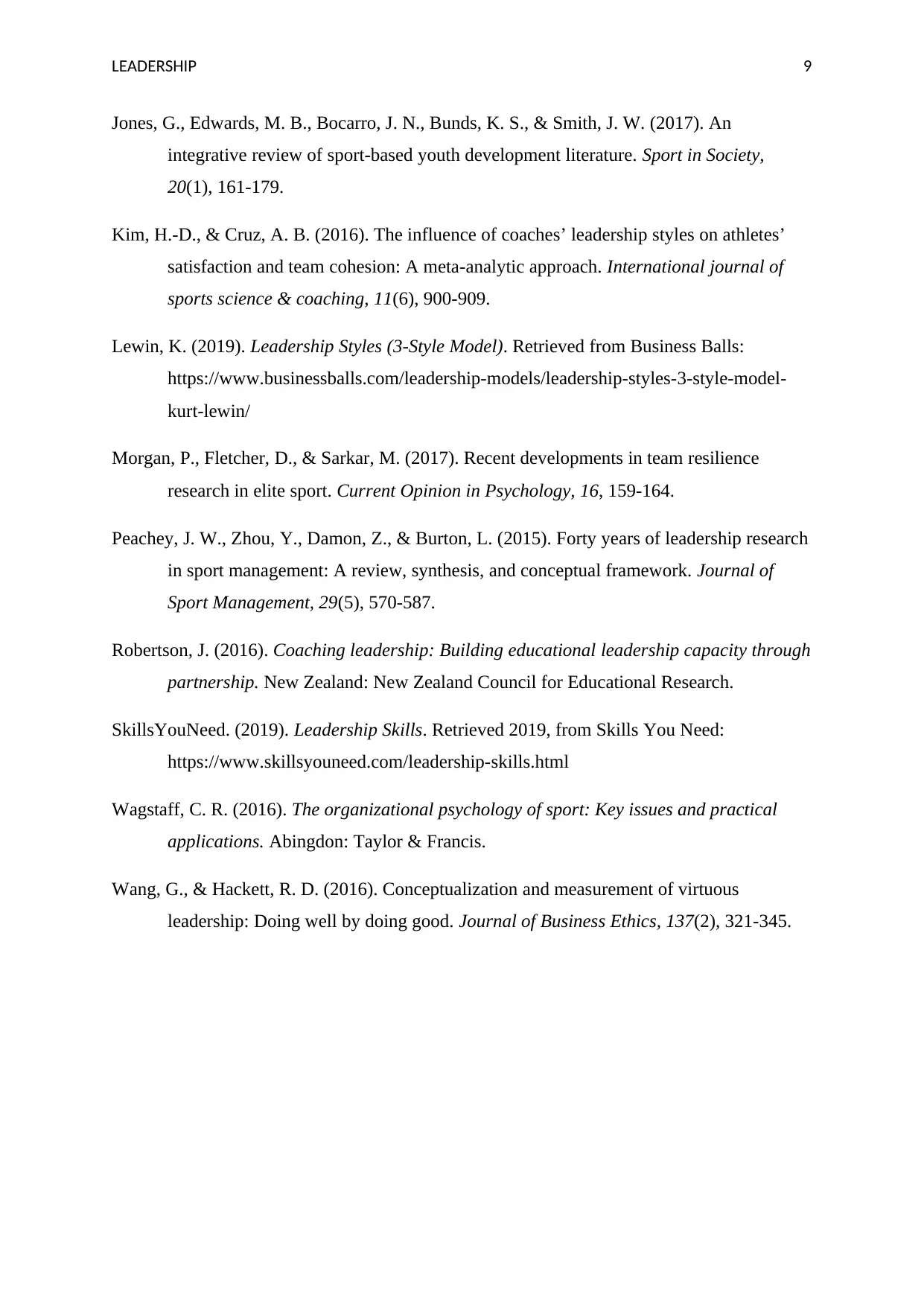
LEADERSHIP 9
Jones, G., Edwards, M. B., Bocarro, J. N., Bunds, K. S., & Smith, J. W. (2017). An
integrative review of sport-based youth development literature. Sport in Society,
20(1), 161-179.
Kim, H.-D., & Cruz, A. B. (2016). The influence of coaches’ leadership styles on athletes’
satisfaction and team cohesion: A meta-analytic approach. International journal of
sports science & coaching, 11(6), 900-909.
Lewin, K. (2019). Leadership Styles (3-Style Model). Retrieved from Business Balls:
https://www.businessballs.com/leadership-models/leadership-styles-3-style-model-
kurt-lewin/
Morgan, P., Fletcher, D., & Sarkar, M. (2017). Recent developments in team resilience
research in elite sport. Current Opinion in Psychology, 16, 159-164.
Peachey, J. W., Zhou, Y., Damon, Z., & Burton, L. (2015). Forty years of leadership research
in sport management: A review, synthesis, and conceptual framework. Journal of
Sport Management, 29(5), 570-587.
Robertson, J. (2016). Coaching leadership: Building educational leadership capacity through
partnership. New Zealand: New Zealand Council for Educational Research.
SkillsYouNeed. (2019). Leadership Skills. Retrieved 2019, from Skills You Need:
https://www.skillsyouneed.com/leadership-skills.html
Wagstaff, C. R. (2016). The organizational psychology of sport: Key issues and practical
applications. Abingdon: Taylor & Francis.
Wang, G., & Hackett, R. D. (2016). Conceptualization and measurement of virtuous
leadership: Doing well by doing good. Journal of Business Ethics, 137(2), 321-345.
Jones, G., Edwards, M. B., Bocarro, J. N., Bunds, K. S., & Smith, J. W. (2017). An
integrative review of sport-based youth development literature. Sport in Society,
20(1), 161-179.
Kim, H.-D., & Cruz, A. B. (2016). The influence of coaches’ leadership styles on athletes’
satisfaction and team cohesion: A meta-analytic approach. International journal of
sports science & coaching, 11(6), 900-909.
Lewin, K. (2019). Leadership Styles (3-Style Model). Retrieved from Business Balls:
https://www.businessballs.com/leadership-models/leadership-styles-3-style-model-
kurt-lewin/
Morgan, P., Fletcher, D., & Sarkar, M. (2017). Recent developments in team resilience
research in elite sport. Current Opinion in Psychology, 16, 159-164.
Peachey, J. W., Zhou, Y., Damon, Z., & Burton, L. (2015). Forty years of leadership research
in sport management: A review, synthesis, and conceptual framework. Journal of
Sport Management, 29(5), 570-587.
Robertson, J. (2016). Coaching leadership: Building educational leadership capacity through
partnership. New Zealand: New Zealand Council for Educational Research.
SkillsYouNeed. (2019). Leadership Skills. Retrieved 2019, from Skills You Need:
https://www.skillsyouneed.com/leadership-skills.html
Wagstaff, C. R. (2016). The organizational psychology of sport: Key issues and practical
applications. Abingdon: Taylor & Francis.
Wang, G., & Hackett, R. D. (2016). Conceptualization and measurement of virtuous
leadership: Doing well by doing good. Journal of Business Ethics, 137(2), 321-345.
1 out of 10